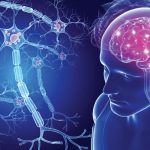La multiple sclerosis is a disease chronic inflammatory autoimmune affecting the brain spinal cord and peripheral nerve roots. It is the second leading cause of acquired disability after trauma.
Its prevalence in France is estimated at 110. 4000 to 6000 new patients are diagnosed each year! It particularly affects young subjects with a clear female predominance (3 times more frequent in women).
MS can progress through spurts, or in a way keep on going et progressive. It is manifested by a large number of symptoms. Its diagnosis is based on a bundle of clinical and paraclinical arguments.
Unfortunately, there is currently no treatment that can cure multiple sclerosis. The drugs used only have the role to space out thrusts et to improve the quality of life patients. However, very promising new therapeutic strategies are being developed and could significantly change the prognosis of this disease!
What is multiple sclerosis?
La sclerosis en plates, or MS, is a disease autoimmune affecting the central nervous system. This means that the immune system, which is supposed to fight various external and internal aggressions (viral, bacterial, parasitic infections, tumours, etc.), attacks its own constituents. In the case of MS, it is the myelin sheath that is attacked and destroyed.
La myelin is a lipid substance that forms a sheath around axons. As a reminder, axons are extensions of neurons (CNS cells). They are responsible for conducting nerve impulses to a target cell. They bundle together to form the nerve fibers (nerves) and white matter of the brain.
This myelin sheath has two main roles: protecting nerve fibers and isolating them, increasing the speed of conduction of nerve impulses. Imagine the nerve fiber as an electric wire, and the myelin sheath as the plastic surrounding and insulating the wire.
Consequently, the alteration or destruction of the myelin sheath, a phenomenon called "demyelination", leads to nerve conduction problems, either by the slowing down or by the defect in the transmission of nerve impulses in advanced forms of multiple sclerosis. This is the mechanism behind the various symptoms observed during this disease.
What are the symptoms of multiple sclerosis?
La multiple sclerosis is typically revealed between the ages of 20 and 40 by the onset of neurological symptoms affecting different functions – such as vision, motor skills or sensitivity – during flare-ups "dispersed in time and space". This means that the lesions during this disease can concern different locations (dissemination in space), and occur during different periods (dissemination in time).
- Motor disorders: this can be manifested at the beginning by walking disorders with significant fatigability, muscle cramps, spasms... At an advanced stage, the symptoms are more marked: speech difficulties, motor incapacity going as far as total dependence ( bedridden state)…
- Sensitivity disorders: numbness and tingling sensation (called paresthesia), electric shock sensation along the spine during certain movements, facial pain (pain in the face), loss of sensitivity in certain areas, inability to feel hot or cold (loss of thermal sensitivity)…
- Vision disorders: which can result in a decrease in visual acuity, ocular and orbital pain increased by the movements of the eyeballs, a blind spot in the visual field and an anomaly in color perception. This type of symptom is evidence of inflammatory damage to the optic nerve with destruction of its myelin sheath. That's what we call “retrobulbar optic neuritis”.
- Chronic pain: they can concern any part of the body such as the legs, the face, the eyeballs, the back (Note: To know everything about the link between multiple sclerosis and low back pain, see the following article).
- Balance disorders and dizziness (vestibular syndrome).
- Coordination disorders during voluntary movements (ataxia).
- Genital disorders: impotence in men.
- Sphincter disorders: urinary retention, urinary incontinence, urgency. This increases the risk of urinary tract infection and greatly affects the quality of life of patients.
- Paralysis of the face: by demyelinating lesion of the facial nerve.
- Double vision: evidence of damage to the innervation of the oculomotor muscles.
- Hearing loss (hearing loss).
- Psychiatric disorders: depression, mood disorders, psychotic disorders. They are the consequence of localized lesions in certain regions of the brain controlling emotions (limbic system).
Symptoms of multiple sclerosis usually progress in a context of profound asthenia, permanent fatigue. It is considered by more than half of the patients as the symptom that bothers them the most. It's a real invisible handicap!
What are the progressive forms of multiple sclerosis?
According to the evolution of multiple sclerosis, there are mainly three progressive forms:
- Remitting form: it is characterized by relapses (the onset of symptoms) interspersed with periods of remission. The relapse phases can leave sequelae that persist during the remission phases. This form represents 85% of early multiple sclerosis and appears around the age of 30.
- Secondary progressive form: a relapsing form may evolve and become progressive. That is to say, no alternating relapses-remissions, but permanent and progressively evolving symptoms. This form sets in on average after 15 to 20 years of progression of the disease.
- Primary progressive form: here, there is no onset phase with a relapsing form. The evolution is progressive and continuous from the outset, without periods of remission. It represents about 15% of cases and is revealed a little later, around the age of 40, against 30 years for the relapsing form.
How is MS diagnosed?
Currently, there is no specific examination that allows the diagnosis of multiple sclerosis to be established with certainty. The latter is then based on a bundle of arguments clinical – dissemination of symptoms in time and space sought by careful questioning and a complete clinical examination – and paraclinical (presence of plaques on MRI, inflammatory syndrome on lumbar puncture).
Multiple sclerosis is a diagnostic exclusion. This means that the neurologist confirms it only after having ruled out all other diseases that may manifest themselves with similar symptoms. Something somewhat tricky, because MS mimics the clinical picture of many diseases.
Here are some criteria for making the diagnosis of multiple sclerosis:
- Dissemination of lesions over time: the patient is asked about the succession of his symptoms. He may, for example, present with retrobulbar optic neuritis with visual disturbances at time T, then suffer from cerebellar ataxia (movement coordination disorder) 1 or 2 months later.
This temporal dissemination can also be highlighted by carrying outmagnetic resonance imaging (IRM) clear. The appearance of new plaques between 2 IRM or the coexistence of lesions of different ages in the same MRI demonstrates this objectively.
- Dissemination of lesions in space: it is defined by the attack of several zones of the central nervous system. This spatial dissemination can be researched clinically: for example the occurrence of visual and sensory symptoms (2 lesions in different locations), or through imaging (IRM) by the coexistence of lesions (plaques) of different locations.
- CNS inflammatory syndrome: objectified by lumbar puncture and cytochemical analysis of cerebrospinal fluid (CSF). Since multiple sclerosis is an autoimmune disease, CSF analysis may show antibodies (but not always). It is also useful because it helps rule out other differential diagnoses.
- Evoked potentials: these are specialized examinations that objectively measure visual, somatosensory and auditory functions. Sometimes they can detect subclinical sensory damage. For example, a slight decrease in hearing, which is not felt by the patient, can be detected by performing auditory evoked potentials.
To summarize, the diagnosis of multiple sclerosis is mainly based on clinical data (questioning and physical examination) and on theimagery by resonance magnetic (MRI). The latter represents the reference examination in the diagnosis and follow-up of MS.
Treatment of multiple sclerosis
At the moment, multiple sclerosis is unfortunately not curable. Its management is based on treatments with the sole objectives of:
- Limit the frequency of flare-ups.
- Accelerate recovery after flare-ups.
- Improve sequelae symptoms.
To achieve these objectives, different classes of treatments are used:
Treatment of flare-ups
To shorten the duration of flare-ups and reduce recovery time, the patient is prescribed high doses of corticosteroids. This class of drugs does not prevent future flare-ups. They are not even used systematically, it all depends on the intensity of the symptoms.
Background treatment
This therapeutic class reduces the frequency and intensity of multiple sclerosis flare-ups. Ultimately, it slows down the progression and general evolution of the disease.
There are 2 main basic treatment types: immunomodulators (interferons) and immunosuppressants (natazilumab, mitoxantrone, etc.). Both reduce, to varying degrees, the activity of the immune system. Remember that multiple sclerosis is a autoimmune disease, so it is normal to treat it by trying to stop this self-aggression on the part of the immune cells.
Treatment of symptoms
An endless list of medications can be offered to patients with the aim of reducing their symptoms and improve their comfort. Here are some examples :
- Analgesics: to fight against pain such as facial pain, peripheral neuropathies… You can use simple analgesics (first level: paracetamol), tricyclics, antiepileptics… It all depends on the intensity of the pain.
- Antispastics: to combat muscle spasticity. In particular, we use dantrolene or botulinum toxin (to relax the muscles).
- Anticholinergics: to treat an overactive bladder resulting in urgent urination.
- Alpha blockers: to treat dysuria (difficulty passing urine).
- Psychotherapeutic support of a possible depressive syndrome, in particular by antidepressants.
- Sexology follow-up and taking certain medications to improve sex life.
- Physiotherapy : it is an essential element of optimal management of multiple sclerosis. All patients must benefit from physiotherapy treatment to relieve, delay the onset or prevent the aggravation of muscle and joint stiffness, clumsiness, gait disturbances, back pain, muscle weakness, etc.
MS: Prognosis and life expectancy
La multiple sclerosis is a long term illness. It is not curable, but fortunately it is not fatal. People who suffer from it have a slightly reduced life expectancy compared to that of the general population.
On average, the life expectancy of patients with MS is reduced by 6 to 7 years compared to the average life expectancy of the general population.
The prognosis of this disease continues to improve with the progress of science. The treatments make it possible to space out the attacks more and more, to slow down the progression of the lesions as much as possible and to significantly improve the quality of life of the patients by relieving their symptoms.
The basic treatments multiple sclerosis tend to bring the life expectancy of patients closer and closer to that of healthy subjects. Hence the absolute need for good medical care and regular monitoring!
Unfortunately, there is severe forms of multiple sclerosis. More aggressive and rapidly evolving. Patients who suffer from it reach the stage of complete dependence earlier, with bed rest and dementia.
Projects
[1] J.-C. Ouallet and B. Brochet, “Clinical, physiopathological and therapeutic aspects of multiple sclerosis”, EMC-Neurol., flight. 1, no 4, p. 415-457, 2004.
[2] L. Magy, “Multiple sclerosis”, Current. Pharma. Hosp., flight. 5, no 19, p. 14-19, 2009.
[3] D. Brassat, "Physiopathology of multiple sclerosis", Presse Medicale, flight. 39, no 3, p. 341-348, 2010.
[4] P. Gallien, B. Nicolas, and A. Guichet, “Update on multiple sclerosis”, Physiotherapy Rev., flight. 12, no 125, p. 17-22, 2012.
[5] “Multiple Sclerosis (MS)”, Inserm. https://www.inserm.fr/dossier/sclerose-en-plaques-sep/ (accessed February 13, 2022).
[6] “Multiple Sclerosis | French Federation of Neurology ". https://www.ffn-neurologie.fr/grand-public/ Maladies/scl%C3%A9rose-en-plaques (consulted on February 11, 2022).
[7] “Multiple sclerosis – Ministry of Solidarity and Health ". https://solidarites-sante.gouv.fr/soins-et- Maladies/ Maladies/ Maladies-neurodegeneratives/article/la-sclerose-en-plaques (consulted on February 12, 2022).



